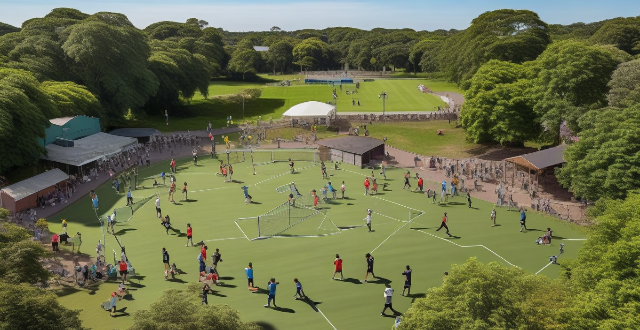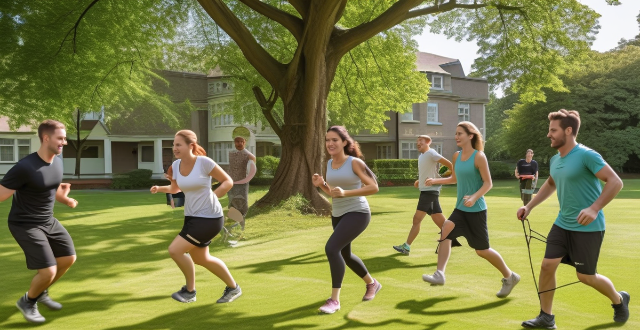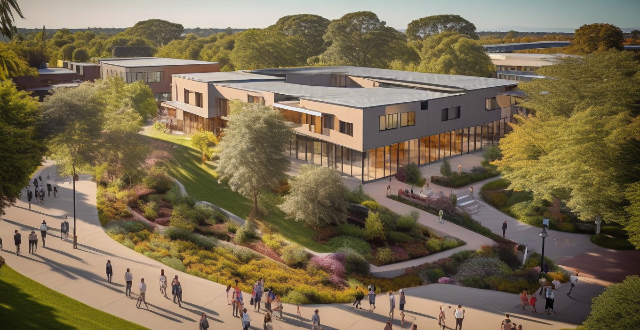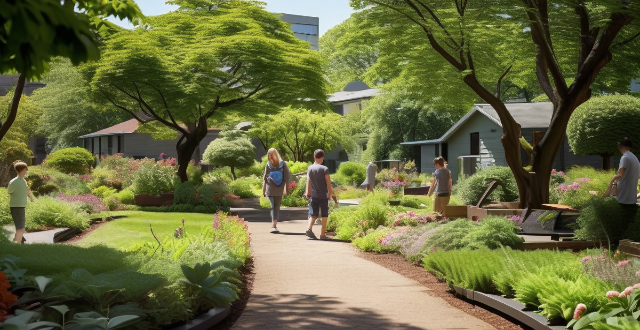Community Rural

What impact does sports have on the social cohesion and community spirit in rural areas ?
The article discusses the impact of sports on social cohesion and community spirit in rural areas. Sports bring people together, promote teamwork, and create a sense of belonging that can strengthen the fabric of a community. The article explores how sports build social capital by forming friendships and encouraging civic engagement. It also highlights how sports promote teamwork and cooperation by teaching communication skills and collaboration towards a common goal. Finally, the article emphasizes how sports create a sense of belonging within a community by supporting local teams and participating in community events. Overall, sports have a significant impact on rural communities and contribute to their overall well-being.

How do climate adaptation strategies differ between rural and urban areas ?
Climate adaptation strategies differ between rural and urban areas due to infrastructure, resources, community needs, and environmental impacts. Urban areas often have advanced technology and diverse stakeholders involved in adaptation planning, while rural areas rely more on local knowledge and community-based initiatives. Funding and resources are also key factors, with urban areas having better access to funding for large-scale projects and a diversified economy to support climate adaptation measures. In contrast, rural areas may have limited financial resources and dependence on agriculture, making them vulnerable to climate impacts. Community participation is crucial in both settings, but urban areas may have more platforms for participatory planning and decision-making processes, while rural areas benefit from strong community cohesion and collective action. Environmental impact considerations also vary, with urban areas facing challenges like the heat island effect and air pollution, while rural areas focus on natural resource management and watershed protection.

How can network coverage be improved in rural areas ?
Improving network coverage in rural areas requires a multi-faceted approach that includes infrastructure development, adoption of advanced technologies, supportive government policies, community participation, and exploration of alternative connectivity solutions. Governments can conduct surveys to assess needs, formulate supportive policies, and allocate budget for rural connectivity. Service providers should invest in R&D, collaborate with other stakeholders, and engage with rural communities to tailor solutions. Local communities should participate in planning, promote digital literacy, and monitor progress.

What are some successful examples of sports-based rural revitalization programs ?
Sports-based rural revitalization programs have been successful in improving economic, social, and cultural conditions of rural areas through sports activities. Examples include China's Hometown Sports Project, India's Rural Sports Development Program, Australia's Grassroots Sports Development Program, and South Africa's Rural Sports Development Project. These programs focus on developing sports infrastructure, training talent, organizing events, and promoting community engagement, contributing to sustainable development and enhancing quality of life in rural areas.

What role can local governments play in promoting sports and rural revitalization ?
Local governments can promote sports and rural revitalization by building sports facilities, offering affordable programs, supporting grassroots organizations, encouraging volunteerism, hosting sports events to attract tourism, and using sports marketing to support local businesses.

How can sports help improve the physical health of rural residents ?
Sports and physical activities can greatly improve the physical health of rural residents by enhancing fitness levels, managing weight, promoting mental well-being, encouraging social interactions, and preventing chronic diseases. It is crucial for local authorities and organizations to promote sports programs and provide accessible facilities to encourage more rural dwellers to engage in physical activities regularly.

How does climate change influence the movement of people from rural to urban areas ?
Climate change significantly impacts human migration patterns, particularly the movement from rural to urban areas. This trend is influenced by direct effects like extreme weather events and changes in agricultural conditions, as well as indirect factors such as economic downturns in rural sectors and social considerations. To reduce rural-to-urban migration driven by climate change, adaptation strategies are needed to enhance resilience in rural areas through sustainable agriculture practices, infrastructure development, economic diversification, and community support programs.

How can we create more opportunities for youth to participate in sports in rural areas ?
Participating in sports is crucial for a child's development, but rural youth often face challenges in accessing sports facilities and programs. To create more opportunities for youth to participate in sports in rural areas, local governments and organizations can build infrastructure, provide equipment and facilities, train coaches and volunteers, organize competitions and tournaments, and promote sports education. By addressing these issues, we can encourage more children to engage in physical activities, develop their skills, and lead healthy lifestyles.

How can we encourage more people to participate in sports activities in rural areas ?
To encourage more people to participate in sports activities in rural areas, a comprehensive approach is needed that includes infrastructure development, education and awareness, community engagement, partnerships and sponsorships, and the use of technology and media. This involves building and maintaining sports facilities, promoting the benefits of physical activity through educational programs, forming local sports clubs and leagues, seeking sponsorships from businesses and government initiatives, and utilizing digital platforms and media coverage to increase visibility and interest in sports activities.

How do climate change impacts differ for men and women in urban vs. rural areas ?
Climate change impacts vary by gender and geography, with urban and rural areas presenting distinct challenges for men and women. Urban men benefit from more job opportunities and adaptation resources, while urban women face vulnerabilities during extreme events, health concerns, and economic disruption. Rural men are often dependent on natural resources for livelihoods and may migrate due to climate change, whereas rural women bear agricultural responsibilities, caregiving roles, and water collection tasks, all of which are affected by climate stressors. Key differences include resource access, infrastructure, livelihood dependencies, and gender roles, with women often bearing a disproportionate burden. Addressing climate change requires recognizing these differences and developing targeted strategies for the most vulnerable populations.

How can I get better cell phone coverage in rural areas ?
Improving cell phone coverage in rural areas can be achieved through various methods. Firstly, checking and optimizing your phone's settings can enhance reception. Secondly, signal boosters or cell phone repeaters can amplify weak signals. Thirdly, switching to a different carrier with better rural coverage might be beneficial. Fourthly, satellite phones offer unparalleled coverage in extremely remote locations. Fifthly, using public Wi-Fi networks can temporarily improve internet connection. Lastly, investing in high-quality antennas can capture weaker signals more effectively.

What are the benefits of promoting sports in rural areas ?
Promoting sports in rural areas can lead to improved physical health, social development, and economic growth. Encouraging sports participation can increase physical activity, reduce the risk of chronic diseases, and improve mental health. Sports can also foster a sense of community, develop youth skills, and promote gender equality. Additionally, hosting sporting events can attract tourism, create job opportunities, and improve infrastructure. Overall, promoting sports in rural areas can contribute to the well-being and development of the community.

How can sports contribute to rural revitalization ?
Sports have the potential to significantly contribute to rural revitalization by enhancing community engagement, promoting health and wellness, and stimulating economic growth. Here are some ways in which sports can play a crucial role: ## Community Building and Engagement ### **Boosting Morale and Unity** - **Festivities and Events:** Sporting events often become festive occasions where people from different backgrounds come together to support their local teams. This fosters a sense of community and belonging. - **Common Goals:** The pursuit of victory in sports creates a shared objective that unites residents and encourages collective effort and pride. ### **Youth Development** - **Skills and Discipline:** Participation in sports teaches young people valuable life skills such as discipline, teamwork, and leadership. - **Positive Outlets:** Sports provide youth with constructive activities, keeping them away from idleness and potential negative influences. ### **Social Inclusion** - **Breaking Down Barriers:** Sports can help to break down social barriers, integrating marginalized groups into the wider community. - **Intergenerational Activities:** Sports can involve people of all ages, from children to the elderly, creating intergenerational connections. ## Health and Wellness Promotion ### **Physical Activity** - **Fitness and Health:** Engaging in sports improves physical fitness, reducing the risk of various health issues like obesity, heart disease, and diabetes. - **Mental Health:** Exercise releases endorphins, contributing to reduced stress levels and improved mental health. ### **Healthy Lifestyle Habits** - **Nutrition Awareness:** Athletes and those involved in sports often pay more attention to nutrition, inspiring others to follow suit. - **Preventive Care:** The emphasis on physical well-being through sports can lead to greater awareness of preventive healthcare measures. ## Economic Stimulation and Development ### **Tourism and Revenue** - **Sporting Events:** Attracting tournaments and competitions can bring tourists to rural areas, providing a significant boost to local businesses. - **Retail Opportunities:** Sports fans often purchase related merchandise, supporting local retailers and entrepreneurs. ### **Infrastructure Development** - **Facilities Construction:** Building sports facilities can create jobs during construction and provide long-term employment opportunities. - **Public Works:** Improved roads, parking lots, and other public works may be developed in conjunction with sports venues to serve both athletes and the general public. ### **Employment Generation** - **Coaching and Training:** As interest in sports grows, there will be increased demand for coaches, trainers, and other sports professionals. - **Support Services:** Hotels, restaurants, transportation services, and other businesses benefit from an increased need for support services during sporting events. ## Cultural Preservation and Identity ### **Traditional Sports** - **Cultural Heritage:** Some sports have deep cultural roots in rural communities and can be preserved and promoted as part of local heritage. - **Community Pride:** Successful local teams or athletes can become symbols of community pride and identity. ### **Educational Programs** - **School Curricula:** Incorporating sports programs into schools not only benefits students physically but also educationally by teaching them about their cultural history through sports. - **Community Workshops:** Hosting workshops on traditional sports can engage the community and preserve intangible cultural heritage.

What challenges do rural areas face when it comes to sports facilities and infrastructure ?
Rural areas face numerous challenges in providing sports facilities and infrastructure, including lack of funding, inadequate infrastructure, transportation issues, limited recreational opportunities, accessibility and inclusivity concerns, low community engagement and participation, and weather and environmental factors. To overcome these challenges, rural communities can partner with local organizations, seek government grants, promote community involvement, and explore innovative solutions like mobile sports units or temporary facilities.

How can immigrants effectively integrate into a new community ?
Effective integration of immigrants into a new community involves learning the local language, engaging with the community, embracing cultural differences, building a support network, seeking out resources, and being patient and persistent. These strategies can help immigrants communicate effectively, find employment opportunities, understand the culture, make friends, and navigate the legal processes involved in immigration.

What are the best practices for setting up a women's empowerment project in a rural area ?
Best practices for setting up a women's empowerment project in rural areas include understanding the local context, involving local stakeholders, designing a holistic program, ensuring accessibility and inclusivity, promoting economic opportunities, enhancing health and well-being, building leadership and decision-making skills, and monitoring progress and evaluating impact.

How can we involve community members in climate adaptation planning ?
Community engagement is crucial for successful climate adaptation planning. To involve community members, identify and engage stakeholders, develop a stakeholder engagement plan, use multiple channels of communication, involve community members in decision making, provide training and education, foster partnerships and collaboration, and monitor and evaluate progress. By doing so, you can create a more resilient community that is better prepared for the impacts of climate change.

Can rural areas benefit from 5G network deployment ?
The advent of 5G technology promises to revolutionize the way we live, work, and communicate. With its faster speeds, lower latency, and increased capacity, 5G has the potential to transform various sectors, including healthcare, education, transportation, and more. However, the question remains: can rural areas also benefit from 5G network deployment? Benefits of 5G in Rural Areas: - Improved Connectivity: Faster Internet Speeds and Reduced Latency - Enhanced Quality of Service: Better Coverage and Increased Capacity - Economic Development: Job Creation and Business Opportunities - Social Benefits: Education and Healthcare Challenges and Considerations: - Infrastructure Costs: High Initial Investment and Maintenance Expenses - Geographic Barriers: Topography and Population Density - Regulatory Hurdles: Spectrum Allocation and Compatibility Issues Conclusion: While there are certainly challenges associated with deploying 5G networks in rural areas, the potential benefits are significant. Improved connectivity, enhanced quality of service, economic development, and social benefits all stand to gain from the introduction of 5G technology. As long as these challenges are addressed through careful planning, collaboration between stakeholders, and appropriate investment, rural areas can indeed benefit from 5G network deployment.

How can we measure the effectiveness of community climate adaptation efforts ?
Measuring the effectiveness of community climate adaptation efforts is crucial for understanding their impact on resilience to climate change. Key steps include setting clear objectives, developing relevant indicators, collecting and analyzing data, transparent reporting, evaluating success, iterative improvement, community engagement, and policy alignment. By following these steps, communities can ensure their adaptation efforts are effective and continuously improved.

What role do community gardens play in city greening efforts ?
Community gardens play a significant role in city greening efforts by providing environmental, social, economic, and urban planning benefits. These gardens improve air quality, enhance biodiversity, and promote soil health. They also foster community building, offer educational opportunities, and contribute to health promotion. Economically, community gardens provide food security and create job opportunities. Integrated into urban planning, they beautify cities and promote sustainable development. Overall, community gardens are vital for ecological health and improving residents' quality of life.

How do sports events promote social interaction and community building ?
Sports events play a significant role in promoting social interaction and community building. They bring people together, foster a sense of belonging, and create opportunities for individuals to connect with one another. This is achieved through encouraging participation, building community spirit, providing entertainment and recreation, facilitating networking opportunities, and enhancing diversity and inclusion. By bringing people together around a shared passion for sports, these events create lasting connections and positive experiences that extend far beyond the playing field.

In what ways do women's empowerment initiatives contribute to community development ?
Women's empowerment initiatives are crucial for community development as they address gender inequalities and foster inclusivity. These initiatives benefit not only women but also have a positive ripple effect on the broader community, leading to more sustainable and equitable growth. Economic growth is achieved through increased participation in the workforce, entrepreneurship and innovation, and improved household economics. Social development is promoted through health and well-being, education, and gender equality. Political empowerment is enhanced through increased participation in decision-making and promotion of good governance. Environmental sustainability is ensured through resource management and climate action. Cultural preservation and exchange are enriched through artistic expression and cultural exchange. Women's empowerment initiatives are essential for comprehensive community development, addressing gender inequalities, promoting inclusivity, and paving the way for sustainable growth, social cohesion, and a brighter future for all members of the community.

How do sports initiatives support community health and wellbeing in cities ?
Sports initiatives in cities are crucial for promoting physical activity, social interaction, mental health, and overall quality of life. The collaboration between the International Olympic Committee and PATH is a prime example of how these initiatives can make a significant impact on community health. By increasing access to health-enhancing community sport activities, sports initiatives support physical activity, enhance social interaction, improve mental health, raise awareness about health issues, and contribute to economic impact and urban development. These initiatives are valuable investments for city planners and policymakers as they promote community health and wellbeing in urban areas.

What are some successful examples of sports-based community development initiatives ?
Sports-based community development initiatives have been successful in various parts of the world, bringing people together and fostering a sense of community. Some notable examples include Sport for Social Impact, Right to Play, Sport and Recreation Victoria, and Sport England. These organizations use sports to tackle social challenges such as poverty, gender inequality, lack of education, and physical inactivity. Their programs range from soccer games promoting peace in Israel and Palestine to after-school programs teaching life skills in areas affected by war, poverty, and disease. These examples demonstrate the power of sports-based community development initiatives to bring people together, promote health and well-being, and address social challenges.

How can we raise awareness about the importance of community climate adaptation ?
To raise awareness about the importance of community climate adaptation, several strategies can be employed: 1. **Education and Outreach Programs**: Conduct workshops, engage schools, collaborate with media outlets, and develop informational materials to educate people about climate change and its implications. 2. **Community Engagement Initiatives**: Encourage public participation in discussions, foster partnerships with local organizations, and promote civic leadership to drive climate adaptation efforts. 3. **Visual Aids and Creative Approaches**: Use art, performances, exhibits, infographics, and other creative means to communicate the importance of climate resilience. 4. **Online Platforms and Social Media**: Leverage digital tools like social media campaigns, online forums, virtual reality experiences, and interactive apps to reach a wider audience. 5. **Policy Advocacy and Support**: Advocate for favorable policies, provide financial incentives, and support legislation that enhances community resilience against climate change.

What role do sports organizations play in fostering community engagement and participation ?
The text discusses the role of sports organizations in fostering community engagement and participation. It highlights their contributions in various areas including community building, educational outreach, economic impact, and social responsibility. Sports organizations promote social interaction by offering memberships, organizing events, and providing volunteer opportunities. They enhance diversity and inclusion through inclusive policies, adaptive sports programs, and cultural celebrations. In terms of educational outreach, they promote health and wellness through fitness programs, workshops, and school collaborations. They also develop life skills such as leadership, character development, and career opportunities. Sports organizations stimulate local economies by hosting tournaments and events, promoting sports tourism, and creating jobs. They support local businesses through partnership programs, community marketplaces, and merchandise sales. Additionally, sports organizations demonstrate social responsibility by adopting green initiatives, planning eco-friendly events, launching educational campaigns, organizing fundraising events, having athlete ambassadors, and offering matching gift programs. Overall, sports organizations play a crucial role in building social connections, enhancing diversity and inclusion, providing educational outreach, stimulating local economies, and embracing social responsibility.

Can sports be used as a tool for social change and community development ?
This text discusses the potential of sports as a tool for social change and community development. It highlights how sports can break down barriers, promote health and well-being, and contribute to education and personal development. The article also explores how sports can address social issues, empower communities economically, and promote peace and reconciliation. However, it emphasizes the need for equitable resource allocation, accessibility, and sustainability to fully realize the potential of sports in societal transformation.

What role do sports clubs and community centers play in promoting public health initiatives ?
Sports clubs and community centers significantly contribute to public health efforts by offering programs and services that encourage physical activity, provide educational opportunities, build social support networks, target specific demographics, and collaborate with health organizations. These establishments play a crucial role in promoting healthier lifestyles through their facilities, workshops, group activities, youth and senior programs, and partnerships with hospitals and awareness campaigns. By catering to diverse age groups and interests, sports clubs and community centers help foster a culture of health and wellness within communities.

How can I gauge the level of parental involvement and community support at a school ?
Gauging the level of parental involvement and community support at a school is crucial for parents when choosing an educational institution for their child. This can significantly impact a student's academic performance and overall development. To gauge these factors, parents can observe school events, talk to other parents, and research the school's reputation. When observing school events, parents should attend open houses, sports games/concerts, and volunteer opportunities to assess the turnout and engagement of parents during these events. A high turnout and active participation suggest strong parental involvement and community support. Parents can also connect with other parents through social media groups, PTA meetings, school drop-off/pick-up times, and school events to ask about their experiences regarding parental involvement and community support at the school. Asking about their level of involvement, supportiveness of the school, communication channels, and impact on student performance can provide valuable insights. Researching the school's reputation online through reviews, rankings, news articles, social media, forums, and message boards can also help gauge parental involvement and community support. Analyzing historical data such as enrollment trends, fundraising results, alumni success rates, and school surveys/feedback can further indicate the level of these factors over time. In conclusion, gauging the level of parental involvement and community support at a school involves attending school events, talking to other parents, and researching the school's reputation. By doing so, parents can make informed decisions about choosing the right school for their child that fosters a supportive and engaging environment conducive to academic success and overall development.

How can sports clubs and teams collaborate with local authorities to support community development projects ?
This topic discusses how sports clubs and teams can collaborate with local authorities to contribute to community development projects. It outlines steps such as understanding the local landscape, building partnerships, implementing projects, and evaluating impact. The text emphasizes the importance of mutually beneficial initiatives and clear communication channels between stakeholders. It also provides examples of project implementation, such as youth mentorship programs and community clean-up days. Finally, it stresses the need for continuous evaluation and improvement to ensure effective use of resources and ongoing community benefit.